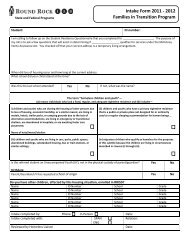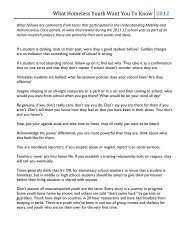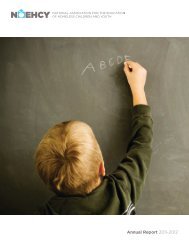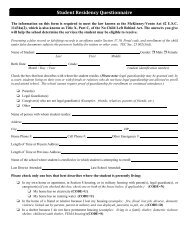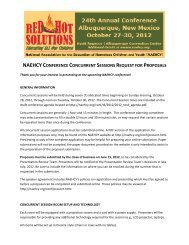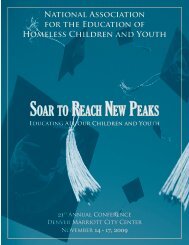The McKinney-Vento Act and Children and Youth ... - State of Michigan
The McKinney-Vento Act and Children and Youth ... - State of Michigan
The McKinney-Vento Act and Children and Youth ... - State of Michigan
Create successful ePaper yourself
Turn your PDF publications into a flip-book with our unique Google optimized e-Paper software.
<strong>and</strong> roundtable discussions with school district homeless liaisons <strong>and</strong> child<br />
welfare caseworkers. <strong>The</strong> <strong>State</strong> Coordinator’s Office also intervenes as needed<br />
to facilitate communication between schools <strong>and</strong> local child welfare agencies<br />
on an ongoing basis.<br />
One particularly innovative model for third-party facilitation <strong>of</strong> ongoing<br />
collaboration is Pima County (AZ) Juvenile Court’s Committee to Improve<br />
Educational Outcomes for Court-Involved <strong>Youth</strong>. 41 This novel initiative<br />
provides an ongoing, regular forum for a variety <strong>of</strong> agencies to come together<br />
to identify <strong>and</strong> address challenges. <strong>The</strong> committee has grown to include<br />
six Pima County school districts, Pima Community College, Pima County<br />
Superintendents Office, CPS, Court Appointed Special Advocates (CASA),<br />
juvenile probation, juvenile detention, group care facilities, the public<br />
defender, contract attorneys, the county attorney, the Attorney General’s<br />
<strong>of</strong>fice, <strong>and</strong> all areas <strong>of</strong> juvenile court. Over the past four years, the committee<br />
has addressed such issues as information sharing between schools <strong>and</strong> child<br />
welfare workers, a judicial checklist to incorporate education concerns <strong>and</strong><br />
outcomes into court proceedings, educational decision making for youth in<br />
out-<strong>of</strong>-home care, <strong>and</strong> collaborative interdisciplinary training.<br />
Some states have established interagency task forces at the state level.<br />
Delaware is home to two different state-level collaboration teams for youth<br />
in out-<strong>of</strong>-home care. Initially, an informal team consisting <strong>of</strong> staff from the<br />
Departments <strong>of</strong> Social Services, Public Health, <strong>and</strong> Education gathered<br />
to share challenges <strong>and</strong> strategies in serving youth in care. Later, the state<br />
legislature established the Child Protection <strong>and</strong> Accountability Commission<br />
(CPAC) to provide oversight <strong>and</strong> <strong>of</strong>fer recommendations for improving<br />
the overall child welfare system. CPAC has <strong>of</strong>fered powerful opportunities<br />
for broad-based collaborations in supporting youth. It has also served as<br />
the forum for drafting the state’s law applying the <strong>McKinney</strong>-<strong>Vento</strong> <strong>Act</strong><br />
to all youth in out-<strong>of</strong>-home care, as well as a detailed Memor<strong>and</strong>um <strong>of</strong><br />
Underst<strong>and</strong>ing (see, Legal Center for Foster Care & Education, www.abanet.<br />
org/child/education).<br />
Casey Family Programs has brought together child welfare <strong>and</strong> education<br />
agencies nationally, at the annual conference <strong>of</strong> the National Association for<br />
the Education <strong>of</strong> Homeless <strong>Children</strong> <strong>and</strong> <strong>Youth</strong> (NAEHCY) as well as at the<br />
state <strong>and</strong> local level across the country. <strong>The</strong>se meetings have jump-started<br />
<strong>and</strong> helped maintain powerful collaborations in Alaska <strong>and</strong> Arizona, among<br />
others. (Legal Center for Foster Care & Education, www.abanet.org/child/<br />
education includes Convening Notes from Casey Family Programs’ ongoing<br />
efforts in Anchorage. <strong>The</strong>se notes outline a helpful structure to facilitate<br />
communication <strong>and</strong> collaboration among agencies serving youth in out-<strong>of</strong>home<br />
care.)<br />
In the Alaska Education<br />
Convening, the group<br />
initially worked together<br />
to answer basic questions<br />
<strong>and</strong> set the stage for active<br />
collaboration:<br />
1. What is the role <strong>of</strong> your<br />
agency in addressing<br />
the educational needs <strong>of</strong><br />
youth in care (in day-today<br />
practice <strong>and</strong> at the<br />
local <strong>and</strong> state levels)?<br />
2. What collaborative<br />
approaches can we<br />
engage in that would<br />
support efforts to address<br />
the educational needs <strong>of</strong><br />
youth in care?<br />
3. What gaps in knowledge<br />
<strong>and</strong> underst<strong>and</strong>ing are<br />
we experiencing? What<br />
information do we need<br />
in order to inform our<br />
practice <strong>and</strong> support<br />
the educational needs<br />
<strong>of</strong> youth in out-<strong>of</strong>-home<br />
care?<br />
Participants then broke into<br />
inter-agency issue groups<br />
to brainstorm specific<br />
strategies for supporting<br />
youth’s education success<br />
in several areas, such as<br />
school stability, academic<br />
supports, <strong>and</strong> mental <strong>and</strong><br />
physical health.<br />
Continued on page 26.<br />
Strategies for Improving Educational Outcomes through School Stability 25




